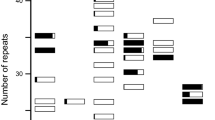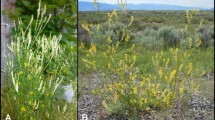Abstract
Twenty-two provenances ofCapsella bursa-pastoris (Brassicaceae) from Patagonia and Tierra del Fuego and 13 provenances from the middle part of South America have been investigated for phenotypic traits (flowering, growth form parameters, fruit characters), isozymes (AAT, GDH, LAP), and RAPDs.Capsella is native to Europe and was introduced into South America in the 16th century. In Patagonia, we detected 23 different multilocus associations, but only five occurred in a frequency of more than 5%. By comparison with the geographic distribution patterns of multilocus genotypes in Europe, we inferred the ancestral European gene pools and the possible introduction routes. A particular multilocus genotype (MMG) was most frequent in the investigated area, and is native to the Iberian Peninsula. This genotype was with all probability introduced by Spaniards into central and northern South America, and it could have reached Patagonia from the north step by step. Other genotypes probably used a direct route from Europe, most likely via British sheep farmers in the second half of the 19th century. Rare genotypes in Patagonia may have been introduced recently by chance, or might be due to multilocus rearrangements in connection with rare outcrossing events. RAPD markers helped to trace colonial gene pools outside Europe and ancestral European gene pools and support the isozyme studies. Correlations between the life history traits and allozyme markers give evidence of the role adaptation may play in the colonizing process.
Similar content being viewed by others
References
Allard R.W., Garcia P., Saenz-de-Miera L.E., Perez de la Vega M. (1939): Evolution of multilocus genetic structure inAvena hirtula andAvena barbata.Genetics 135: 1125–1139.
Bernhardt K.-G. (1989): Pflanzliche Strategien der Pionierbesiedlung terrestrischer und limnischer Sandstandorte in Nordwestdeutschland.Drosera 1989: 113–124.
Chaboudez P. (1994): Patterns of clonal variation in skeleton weed (Chondrilla juncea), an apomictic species.Austral. J. Bot. 42: 283–295.
Coquillat M. (1951): Sur les plant les plus communes de la surface du globe.Bull. Mens. Soc. Linn. Lyon 20: 165–170.
Crosby A.W. (1986):Ecological imperialism. The biological expansion of Europe, 900–1900, Cambridge University Press, Cambridge.
Doyle J.J. &Doyle J.L. (1987): A rapid DNA isolation procedure for small quantities of fresh leaf tissue.Phytochem. Bull. 19: 11–15.
Garcia P., Morris M.I., Saenz-de-Miera L.E., Allard R.W., Perez de la Vega M. &Ladizinski G. (1991): Genetic diversity and adaptedness in tetraploidAvena barbata and its diploid ancestorsAvena hirtula andA. wiestii.Proc. Natl. Acad. Sci. U.S.A. 88: 1207–1211.
Garcia P., Vences F.J., Perez de la Vega M. &Allard R.W. (1989): Allelic and genotypic composition of ancestral Spanish and colonial Californian gene pools ofAvena barbata: evolutionary implications.Genetics 122: 687–694.
Garleff K. (1977): Höhenstufen der argentinischen Anden in Cujo, Patagonien und Feuerland.Göttinger Geogr. Abh. 68.
Groves R.H. (1986): Invasions of Mediterranean ecosystems by seeds. In:Dell B., Hopkins A.J.M. &Lamont B.B. (eds.),Resilience in Mediterranean-type ecosystems, Dr. W. Junk Publishers, Dordrecht, pp. 129–145.
Hurka H. &Düring S. (1994): Genetic control of plastidic L-glutamate dehydrogenase isozymes in the genusCapsella (Brassicaceae).Heredity 72: 126–131.
Hurka H., Freundner S., Brown A.H.D. &Plantholt U. (1989): Aspartate aminotransferase isozymes in the genusCapsella (Brassicaceae): subcellular location, gene duplication, and polymorphism.Biochem. Genet. 27: 72–90.
Hurka H. &Haase R. (1982): Seed ecology ofCapsella bursa-pastoris (Cruciferae): Dispersal mechanisms and the soil seed bank.Flora 172: 35–46.
Hurka H. &Neuffer B. (1997): Evolutionary processes in the genusCapsella (Brassicaceae).Pl. Syst. Evol. 206: 295–316.
Liss C.-C. (1979): Die Besiedlung und Landnützung Ostpatagoniens.Göttinger Geogr. Abh. 73.
Nei M. &Li W.-H. (1979): Mathematical model for studying genetic variation in terms of restriction endonucleases.Proc. Natl. Acad. Sci. U.S.A. 76: 5269–5273.
Neuffer B. (1990): Ecotype differentiation inCapsella.Vegetatio 89: 165–171.
Neuffer B. (1996): RAPD analyses in colonial and ancestral populations ofCapsella bursa-pastoris (L.)Med. (Brassicaceae).Biochem. Syst. Ecol. 24: 393–403.
Neuffer B. &Bartelheim S. (1989): Gen-ecology ofCapsella bursa-pastoris from an altitudinal transsect in the Alps.Oecologia 81: 521–527.
Neuffer B. &Hurka H. (1986): Variation of development time until flowering in natural populations ofCapsella bursa-pastoris (Cruciferae).Pl. Syst. Evol. 152: 277–296.
Neuffer B. &Hurka H. (1999): Colonization history and introduction dynamics ofCapsella bursa-pastoris (Brassicaceae) in North America. Isozymes and quantitative traits.Molec. Ecol. 8: 1667–1681.
Novak S.J. &Mack R.N. (1993): Genetic variation inBromus tectorum (Poaceae): comparison between native and introduced population.Heredity 71: 167–176.
Novak S.J., Mack R.N. &Soltis P.S. (1993): Genetic variation inBromus tectorum (Poaceae): introduction dynamics in North America.Canad. J. Bot. 71: 1441–1448.
Perez de la Vega M., Garcia P. &Allard R.W. (1991): Multilocus genetic structure of ancestral Spanish and colonial Californian population ofAvena barbata.Proc. Natl. Acad. Sci. U.S.A. 88: 1202–1206.
Saitou N. &Nei M. (1987): The neighbor-joining method: a new method for reconstructing phylogenetic trees.Molec. Biol. Evol. 4: 406–425.
Salisbury E.J. (1964):Weeds and aliens. The Naturalist 43, Collins St James's Place, London.
Sambrook J., Fritsch E.F. &Maniatis T. (1989):Molecular cloning: a laboratory manual 1. Ed. 2. Cold Spring Harbor Laboratory Press, Cold Spring Harbor.
Schmithüsen J. (1976).Atlas zur Biogeographie. Bibliographisches Institut AG, Zürich.
Shull H. (1929): Species hybridisations among old and new species of shepherd's purse.Proc. Int. Congr. Pl. Sci. 1: 837–888.
Van de Peer Y. &de Wachter R. (1994): TREECON for windows: a software package for the construction and drawing of evolutionary trees for the Microsoft Windows environment.Computer Applic. Biosci. 10: 569–570.
Walter H. &Lieth H. (1967):Klimadiagramm-Weltatlas. VEB Fischer Verlag, Jena.
Warwick S.I. (1990): Allozyme and life history variation in five northwardly colonizing North American weed species.Pl. Syst. Evol. 169: 41–54.
Warwick S.I. &Black L.D. (1986): Genecological variation in recently established populations ofAbutilon theophrasti (velvetleaf).Canad. J. Bot. 64: 1632–1643.
Willerding U. (1986):Zur Geschichte der Unkräuter Mitteleuropas. K. Wachholtz Verlag, Neumünster.
Author information
Authors and Affiliations
Corresponding author
Rights and permissions
About this article
Cite this article
Neuffer, B., Hirschle, S. & Jäger, S. The colonizing history ofCapsella in Patagonia (South America)—Molecular and adaptive significance. Folia Geobot 34, 435–450 (1999). https://doi.org/10.1007/BF02914921
Issue Date:
DOI: https://doi.org/10.1007/BF02914921




